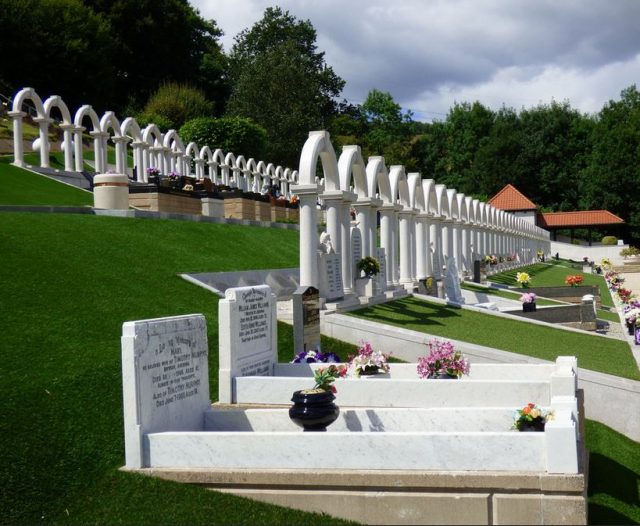21 October 2016
The Aberfan victims and survivors
Posted by Dave Petley
The Aberfan victims and survivors
Today is the 50th anniversary of Aberfan, an event that will be commemorated both at the site and across the United Kingdom. It is of course a day to remember the Aberfan victims, the majority of whom were children and teachers at the Pantglas Junior School, and to hear accounts of the survivors. Those lost are remembered in a simple memorial garden at Aberfan, with two ranks of graves for the victims:

The memorial to the Aberfan victims
.
Of course there were survivors of the disaster too, and various media outlets this week have featured accounts of the day from their perspective. Perhaps the most powerful is an account in the Guardian yesterday, which has printed a letter that a young journalist, Alix Palmer of the Daily Express wrote to her mother having been dispatched to the site. The letter is worth reading in full, but this excerpt is very powerful:
Looking down on that terrible mess of a school from behind on the mountain side with a blanket of slag on it, nothing of the inside of the building could be seen.
Wherever you looked, women stood waiting. You could tell which were the mothers; they weren’t crying, just huddling together. The fathers straight from the pit were digging. No-one had yet really given up hope, although logic told them it was useless.
Every now and again the organiser of the operation would yell through a loud hailer for quiet. That was the most terrible moment of all. Someone had seen an arm or a leg and everyone longed for the sound of a child crying.
The gigantic bulldozer, operating in such confined spaces and with such deafening noise, would stop. The noise of spade against spade and the murmur of orders would cease, the women would draw a little nearer and everyone would hope.
Then a body would be brought out gently, cleared quickly of a casing of slag which clung to the skin and clothing. A doctor would push his way through and everyone waited. Then the doctor would wrap the little body gently in a blanket and it would be carried into the building of corrugated iron which served as a mortuary.
This went on for hours… All through the night we worked, talking to people or trying to, because how can you talk reasonably to mothers who have just identified a dead child?…
At eight o’clock, I went to the school in the next village where the parents were meeting the chief constable. They were asked to fill in forms, listing the children who had been at school that day which was the only way of checking because class registers were still buried. And as the mothers sat down to write the names of their children, the tears came.
I need say no more.


 Dave Petley is the Vice-Chancellor of the University of Hull in the United Kingdom. His blog provides commentary and analysis of landslide events occurring worldwide, including the landslides themselves, latest research, and conferences and meetings.
Dave Petley is the Vice-Chancellor of the University of Hull in the United Kingdom. His blog provides commentary and analysis of landslide events occurring worldwide, including the landslides themselves, latest research, and conferences and meetings.
Thank you for your coverage of this. I appreciated your tracing of this story through both the geology and the human tragedy.
[Many thanks. Aberfan is a story that needs to be told. D].
I well remember that day. I was working as a young nursing sister in a London hospital . We were horrified to see this terrible disaster unfolding on the television. We were stunned into silence and many of us wept.
This year , I recalled that fateful day when I i had the privilege of singing Karl Jenkins’s “Requiem” at Carnegie Hall in New York with the Mornington Peninsula Chorale,( from Victoria , Australia) together with several other choirs.